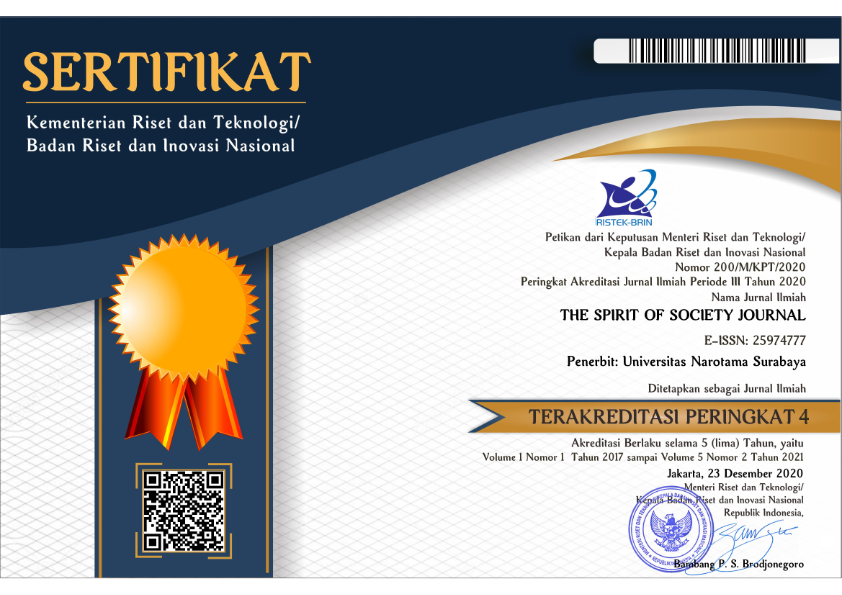From Sukabumi to Amsterdam 1883: Sundanese Society through Parakansalak Tea Plantation Exposition
Abstract
In 1883 the tea plantation in the Parakansalak Sukabumi region brought workers from the local plantation community to Amsterdam, to participate in De Internationale Koloniale en Uitvoerhandel Tentoonstelling. The planter, Mr. Holle, promoted the commodity of tea by including the original culture of the colony's land, precisely the Sundanese ethnicity. Sundanese cultural presentations include gamelan and dance performances and cultural tours of Sundanese society. Europeans directly witnessed people from the colonies playing music and dancing and carrying out daily life activities through village society. This paper describes the existence of the Sundanese society through the Parakansalak plantation group in Amsterdam in 1883, uses a qualitative approach with literature studies, and focuses on situational analysis that examines the activities of the Sundanese people through the Parakansalak tea plantation group at the Exposition Activity in 1883. The purpose of this study was to determine the impact of the existence of the Sundanese people in a new place - in Amsterdam - Europe by introducing Sundanese culture during the Exposition activity. The results obtained were the astonishment of the European community who saw the culture of the colonized nation. The first impression, Europeans see a group of Sundanese people who practice low and primitive culture. Still, it united people of different religions, ethnicities, and skins to fundraising for the Mount Krakatoa disaster in the Dutch East Indies.
Downloads
References
Berg, Norbert van den. (1991).“Een mijner beste Indische vrienden’ De relatie tussen Cd. Busken Huet en A.W. Holle.” in. Indische Letteren Jaargang 6. Werkgroep Indisch-Nederlandse Letterkunde.
Kunto, Haryoto. (1986). Semerbak Bunga di Bandung Raya. Bandung: PT Granesia.
Latifah, Hendarti. (2007). Menepis Kabut Halimun: Rangkaian Bunga Rampai Pengelolaan Sumber daya Alam. Jakarta: Yayasan Pustaka Obor Indonesia.
Moriyama, Mikihiro. (2005). Semangat Baru: Kolonialisme, Budaya Cetak, dan Kesastraan Sunda Abad ke-19. Jakarta: Kepustakaan Populer Geramedia.
Nakagawa, Shin. (2000). Musik dan Kosmos: Sebuah Pengantar Etnomusikologi. Jakarta: Yayasan Obor Indonesia.
Nugraha, A. (2019). The Existence of Gamelan, Kampong, and Mount Krakatoa Eruption Fundraising in Amsterdam Exhibition in 1883. The 5th Rajabath University National & International Research & Academic Conference, 317–322. https://doi.org/10.31227/osf.io/4962g
Ross, Laurie Margot. (2016). The Encoded Cirebon Mask: Materiality, Flow, and Meaning Along Java's Islamic Northwest Coast (Studies on Performing Arts & Literature of the Arts & Literature of the Islamicate World). Boston: Brill Academic Pub.
Setiono, Benny G. (2003). Tionghoa dalam Pusaran Politik: Mengungkap Pakta Sejarah Tersembunyi Orang Tionghoa di Indonesia. Jakarta: Elkasa.
Sumodingrat, Gunawan & Riant Nugroho. (2005). Membangun Indonesia Emas: Model Pembangunan Indonesia Baru menuju Negara-Negara yang Unggul dalam Persaingan Global. Jakarta: Elex Media Komputindo.
Terwen, Jan Willem. (2003). “De Lange En De Gamelan: Een negentiendeeeuwse ontmoeting tussen Oost en West.” Desertasi. Universiteit van Amsterdam.
Wawa, Jannes Eudes. (2011). Ekspedisi Citarum: Sejuta Pesona dan Persoalan Laporan Jurnalistik Kompas. Jakarta: PT Kompas Media Nusantara.
Copyright (c) 2022 THE SPIRIT OF SOCIETY JOURNAL : International Journal of Society Development and Engagement

This work is licensed under a Creative Commons Attribution-ShareAlike 4.0 International License.












